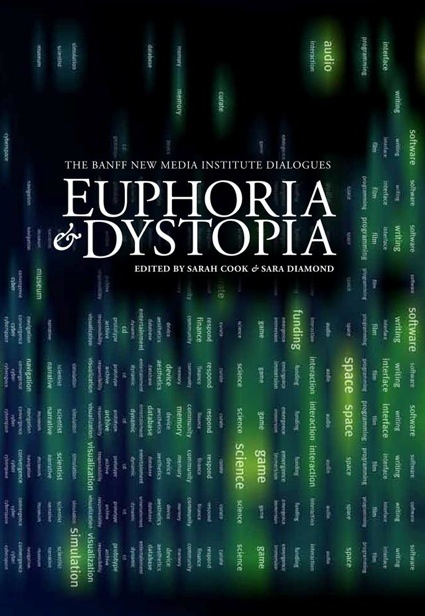Euphoria & Dystopia: The Banff New Media Institute Dialogues, edited by Sarah Cook and Sara Diamond. Foreword by Kellogg Booth and Sidney Fels. Essays by Sandra Buckley, Steve Dietz, Jean Gagnon, N. Katherine Hayles, Eric Kluitenberg, Jeff Leiper, Allucquere Rosanne Stone. Afterword by Susan Kennard.
Available on Amazon USA and UK.

Publishers The Banff Center Press and Riverside Architectural Press write: Euphoria and Dystopia: The Banff New Media Institute Dialogues is a compendium of some of the most important thinking about art and technology to have taken place in the last few decades at the international level. Based on the research of the Banff New Media Institute (BNMI) from 1995 to 2005, the book celebrates the belief that the creative sector, artists and cultural industries, in collaboration with scientists, social scientists and humanists, have a critical role to play in developing technologies that work for human betterment and allow for a more participatory culture. The book is organized by key themes that have underscored the dialogues of the BNMI and within each are carefully edited transcriptions drawn from thousands of hours of audio material documenting BNMI events such as the annual Interactive Screen and the numerous summits and workshops. Each chapter is introduced by an essay from the book editors that discusses the roles of research and artistic co-production at Banff from 1990 to 2005 and a commissioned essay from a leading new media theorist. Includes the catalogue for ‘The Art Formerly Known As New Media’ exhibition, Walter Phillips Gallery, 2005.
I’ll start with a confession: i haven’t read the whole book. My only excuse is that it counts 1100 pages, with small fonts and only very few photos. I’ve had it by the sofa for months. So i read an essay here and there. One by Alexei Shulgin about netart (1998), Eric Kluitenberg’s Notes on the Nature of Collaboration and Networks (2005), excerpts from Luis-Philippe Demers and Bill Vorn’s participation to the summit Flesh Eating Technologies (1997), etc. Sometimes i want to read a text by an artist or theorist i like. Sometimes, i pick up an essay because of the issue it explores (Artificial Stupidity, method an Apparatus for Finding Love, Living Architectures.) So far it’s been a fascinating journey. Euphoria & Dystopia is packed with insightful transcripts of talks, Q&A, ideas, debates, commissioned essays, excerpts by the media artists, curators, media theorists and computer scientists that you’d expect to appear in such publication. But because Banff is a place where people with widely different background and perspectives can meet, the book also contains texts by pharmacologists, nanotechnology researchers, ethnographers, spokespeople from the industry, sports designers, disability ethicists, cognitive scientists, leaders in Aboriginal storytelling, etc. Even a professional snowboarder.
Of course some essays and ideas have aged badly. But i was surprised to realize that most of the texts in the book are still acutely relevant 10 or 15 years on. It’s quite disconcerting to realize that a number of discussions haven’t made much progress over the years. The intro to the catalogue of the 2005 exhibition The Art Formerly Known As New Media, for example, hasn’t lost an ounce of its strength. But even the essays and concepts that seem a bit passé nowadays have a value that goes beyond the archives: they give a context to today’s discussions and debates, reminding us of what we used to think, forecast, fear. We all know how much the art & tech world is in dire need of more context.
I’ve never been to Banff and i know very little about it so i found it difficult to be excited by its history, functioning and sponsorship stories. But, hey, that’s only a small part of this fantastic 1100 pages resource.
Check out also BNMI Archives – Banff New Media Institute.
Image on the homepage: Garnet Hertz, Experiments in Galvanism.
